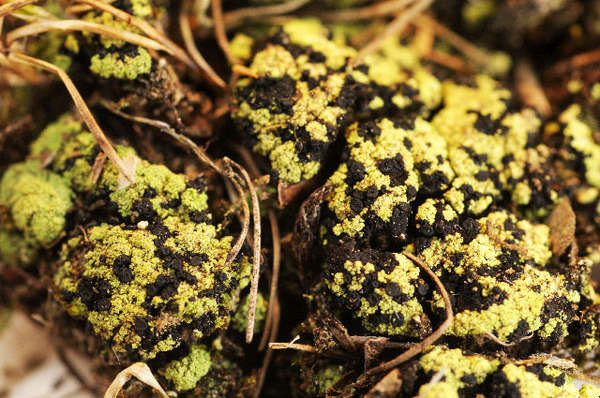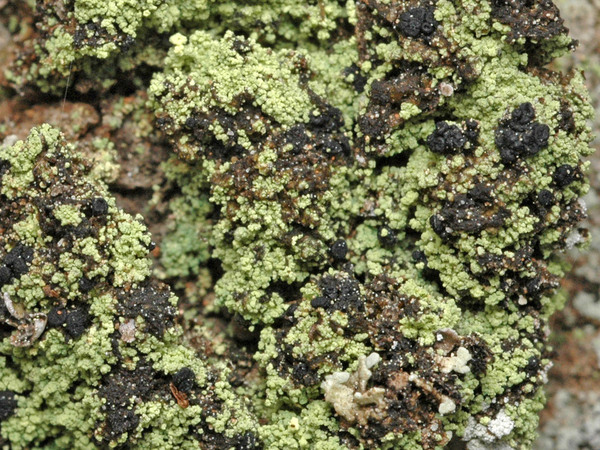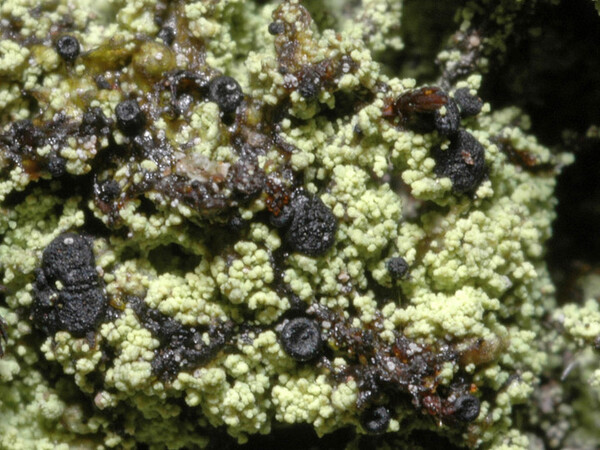Arthrorhaphis citrinella (Ach.) Poelt
Bestimmungsschl. Eur. Flechten: 126, 1969. Basionym: Lichen citrinellus Ach. - K. Vetensk.-Akad. Nya Handl., 16: 135, 1795.
Synonyms: Bacidia citrinella (Ach.) Branth & Rostr.; Bacidia flavovirescens (A. Massal.) Anzi; Bacidia flavovirescens var. citrinella (Ach.) Vain.; Lecanactis citrinella (Ach.) H. Olivier; Lecidea citrinella (Ach.) Ach.; Skolekites citrinellus (Ach.) Norman
Distribution:
Description: Thallus crustose, forming small, irregular, up to 2.5 cm wide patches over saxicolous bryophytes, often dispersed and poorly delimited, greenish-yellow, usually entirely formed of loose, rarely compacted, coralloid aggregations of coarse granular soredia measuring 0.05-0.15(-0.2) mm. Medulla and Ca-oxalate crystals absent. Apothecia lecideine, black, matt, laterally or centrally attached to the granular thallus, more rarely separated from the thallus, single or clustered to 2-8, 0.4-1.0 mm across, adnate to shortly and broadly stipitate, with a flat to distinctly convex, more or less coarsely rugose disc, the margin at first thick and protruding, later level with disc. Proper exciple 55-80 μm wide, dark dirty to brownish olive green, darker towards the outer edge; epithecium brownish olive-green, N+ green, 15-25 μm high; hymenium colourless to pale olive green, densely inspersed with oil droplets, 90-140 μm high; paraphyses sparingly branched and anastomosing, 1-1.5 μm thick; hypothecium brownish olive-green, 50-90 μm high. Asci 8-spored, bitunicate, clavate, I-, scarcely thickened at apex, with a small ocular chamber 100-130 x 10-13 μm. Ascospores (6-)7-11((-15)-septate, hyaline, acicular parallel in the asci, (45-)58-88(-102) x (2-)2.5-3.5(-4) μm. Photobiont chlorococcoid. Spot tests: thallus K-, C-, KC-, P-, UV+ orange. Chemistry: rhizocarpic acid (major), epanorin (minor).Note: the revision by Frisch & al. (2022) showed that A. citrinella can be subdivided into several species. A. citrinella s.str., characterized by a thallus entirely consisting of small loose to compact aggregations of granular soredia, growing on saxicolous bryophytes, while common in Northern Europe, appears to be much rarer in the Alps than the recently-described A. vulgaris. In the TSB herbarium there is no sample from the Italian Alps corresponding to A. citrinella s.str., so I have provisionally attributed all of its records to A. vulgaris.
Growth form: Crustose
Substrata: soil, terricolous mosses, and plant debris
Photobiont: green algae other than Trentepohlia
Reproductive strategy: mainly asexual, by soredia, or soredia-like structures (e.g. blastidia)
Commonnes-rarity: (info)
Alpine belt: absent
Subalpine belt: absent
Oromediterranean belt: absent
Montane belt: absent
Submediterranean belt: absent
Padanian area: absent
Humid submediterranean belt: absent
Humid mediterranean belt: absent
Dry mediterranean belt: absent

Predictive model
Growth form: Crustose
Substrata: soil, terricolous mosses, and plant debris
Photobiont: green algae other than Trentepohlia
Reproductive strategy: mainly asexual, by soredia, or soredia-like structures (e.g. blastidia)
Commonnes-rarity: (info)
Alpine belt: absent
Subalpine belt: absent
Oromediterranean belt: absent
Montane belt: absent
Submediterranean belt: absent
Padanian area: absent
Humid submediterranean belt: absent
Humid mediterranean belt: absent
Dry mediterranean belt: absent

Predictive model
 INDEX FUNGORUM
INDEX FUNGORUM
 GBIF
GBIF
 DOLICHENS
DOLICHENS





